|
Searching for a missing hen this morning, I noticed one of our beehives beginning to swarm. Fortunately they gathered on a tree next door and we were able to capture them. Check it out!
0 Comments
The four major ways I build my soil by adding nutrient rich materials are: composting, worm farming, manure "teas" and mulching. Being short of dollars, I like to make things myself as cheaply as possible. Here I will show you a worm farm I made recently for less than $30. Worm farm bins sell for between $50 and $130 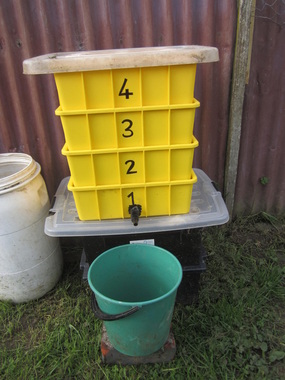 This particular set up is excellent because not only does it provide wonderful worm "tea", a happy home for the worms and rich vermicast for the garden, it has the added bonus of providing a bin full of vermicast minus worms without the usual tedious process of spreading the vermicast in the sun, scraping off a layer, and repeating as the worms move away from the light. That process is all taken care of in the proper running of the worm farm, as you shall see. Materials:
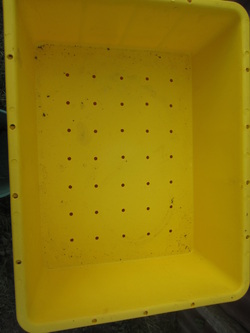 Method:
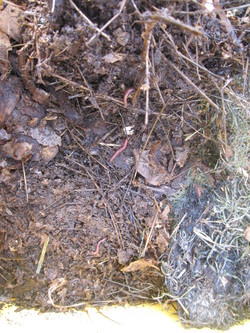 How to use the bin:
Remember: Avoid releasing tiger worms into your vege garden. They will not do well there, as they like to be in close confines for breeding. Also, one commercial worm farmer told me they will eat the roots of your veges, as they are voracious eaters and always looking for fresh organic material. Ensure your worm bin does not get too hot or too cold, too dry or too wet. Contents should be moist but not sopping - if too wet, check drainage and add more dry bedding - newspapers, straw etc. If too dry, wet it down. I position my worm farm in a warm, sunny spot in winter, and a shady spot in summer. Worms like it warm but not hot, and don't like too much light. Beware black bins in the summer sun - you don't want to cook your worms! Don't add more food than they can consume - start slow, and as numbers build up (which happens rapidly!) feed more. I check the bin a couple of times a week, and add more food when what was there is mostly gone. They will also slow down in the cooler months, so feed less then. I have had zero problems with worms escaping or drowning in the bottom bin, unlike with a regular purchased worm bin set up (I have one of those too, leant to me to get started last year). I think it is because if a worm sticks it's head down through the holes in the bottom worm bin, it encounters nothing but air, and so doesn't bother to crawl downwards. With the regular bins, there is a hole-filled tray that sits between the worm bin and the water-catchment bin, and worms were forever crawling between the two and then falling into the water. Plus the liquid is not sitting in the bottom bin, but draining off, so there is no food/manure-smelling liquid to attract them downwards. At least that is my experience with it so far.  Please note: I cannot claim credit for the design of this brilliant worm bin system - I saw the idea in a book I LOVE called Green Urban Living by Kiwi author and gardener Janet Luke. The very first time I ever had chickens was 16 years ago when we moved into a house on a large farm and "inherited" a flock of mostly Brown Shavers. I don't remember how many there were, but I do remember our very citified cat was terrified of them! Since then, I have had various flocks of chickens at different places, though some houses we lived in we were not able to have livestock, so it has varied a bit. The second time we moved into a place and inherited an existing flock of chickens, they included a matronly Barred Rock hen whom I named "Granny" as she appeared to be the matriarch of the flock. Eventually I decided to find out how old she was, and after numerous phone calls back through various owners I found the couple who had first rescued her from a battery hen farm - over 17 years earlier!! They couldn't believe she was still alive - and I couldn't believe she was still laying eggs! In fact, that year she went on to co-mother our very first batch of chicks (17 of them). 5 of the hens had gone broody and kept sharing the nesting boxes of eggs. When it came time to move them and the about-to-hatch eggs to a safer location, I felt sorry for them all and so moved them all together. When the chicks hatched, they shared them with no bickering. If they sensed danger, 4 would rush to a corner, spread their wings and call the chicks to them, uniting to hide them. The fifth hen would rush to the foreground and puff up, peck and cluck like an angry watchdog. It was adorable to see - and in my complete chicken novice-hood I didn't realise it was unusual! 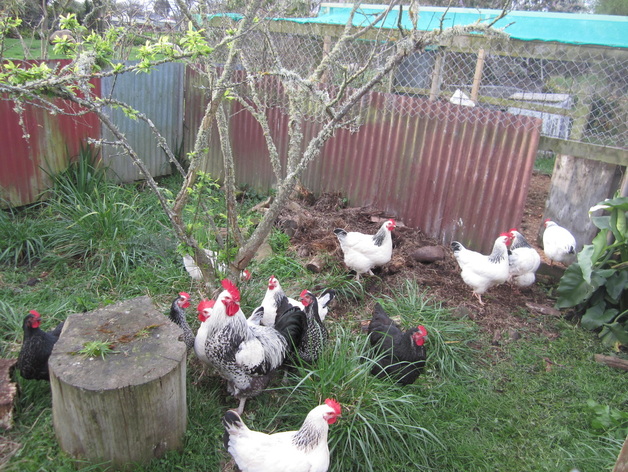 Since we moved to this property 7 years ago, we've had chickens. When we arrived we inherited yet another small flock, the last of whom died recently. 5 or 6 years ago, we allowed our hens to raise some chicks with eggs from the neighbour's hens (we didn't have a rooster at the time). Two of them, bantam crosses, were my children's particular pets, and we still have those two. But otherwise, our flocks are now all new. Above is a picture of some of the main flock. The black hen to the right is a Light Sussex/Barred Rock cross that we raised from a chick along with four white Light Sussex chicks, all of whom were given to us by a friend, initially to raise for the freezer, but then someone else gave us a beautiful Light Sussex rooster, so I decided to keep the young hens and begin breeding my own for meat. The black hen went broody last year, and raised 5 chicks, of whom the rooster pictured was one. So he would be 3/4 Light Sussex, 1/4 Barred Rock, and I think he's really pretty. The hens you see here are all either the original Light Sussex hens, or offspring from the Light Sussex rooster - so some are purebred, and some are crosses either with the Barred Rock (she had another 3 chicks earlier this year) or my Brown Leghorns, one of whom raised 14 chicks this year. There are 15 chickens in this group - their purpose is for both meat and eggs; this year's pullets are just starting to lay. 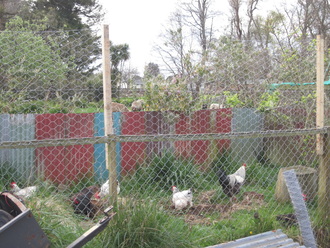 All my chickens, except the bantams, are very adept at flying, and love to hop over the fences and into my gardens! Grrr! Normally they are free-ranged in the paddocks, but lately they've got into such bad habits that I've had to resort to keeping them in their coops until I can raise the fences. Today my son and I completed stage one of Operation Chicken-proof - we raised the side fence of this run area that is adjacent to the main chicken coop. We still need to put a top-half on the gate, and there is a short piece of fence at one end that we also need to raise, but I was able to let the chickens in here this afternoon. Clipping their wings makes no difference, by the way, to their ability to get over my fences! If a fence has a solid part to it near the top (such as a rail) they will happy leap up and check out the other side, then fly down. Chickens, however, dislike flimsy or flexible fence tops, so the new extension has upright fencing battens supporting the wire, but no top rail. 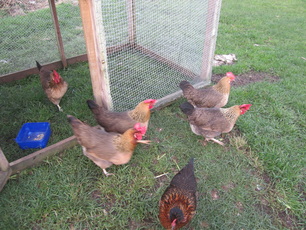 This week I put my 5 Brown Leghorns into one of our moveable runs so I can do an egg-count check. Well, almost moveable - my darling husband built this AWESOME coop to my specifications, with the intention they could be moved around the 8 garden beds I designed last year, but it turned out to be so heavy it's too hard to move that way. So I use it in the paddock, and will at some point design a lighter coop for over the garden beds. Ah well, you live and learn! The chicken in the foreground is one of the Silky Bantam cross pets. The Leghorns were given to me by a friend, so I could put them in the freezer or get rid of them for her - she thought they were too old and not laying. I thought they were pretty and decided to keep them for a while and see if they were laying - that was 2 years ago (they are over 5 years old) and they are still laying very strongly. I really have more hens then I need, so no sure how long I'll keep these girls - or may keep just a couple for breeding purposes if it turns out last year's crosses are particularly excellent hens. These girls are very accomplished in flight too - and they taught the Sussex hens all their bad habits! 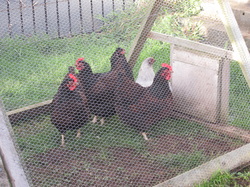 My neighbour is moving soon, and unable to take her hens, who are only 12-18 months old, so I agreed to take them. There are 3 Barnvelders and 2 Aracunas. They are together in another moveable house and run, currently helping turn over my front lawn which will become vege gardens soon. They lay well, but the Aracunas are the most psycho chickens I've ever come across! They go absolutely crazy if you try to pick them up, even in the dark. Getting them over here was a mission and a half - I went to pick them up one night, figuring they'd be calm and quiet like most hens in the dark. Boy, was I wrong - they went ballistic, flying at my head, flying into the fences, running around full-tilt in the dark, fighting anything they came across. Hopefully they'll calm in time. All together I have 27 chickens. Discounting the rooster and bantams, who aren't laying, and four of the pullets who aren't laying yet, that leaves 20 hens who are potentially laying. This week I've been keeping an accurate count of how many eggs I get from which group - and it has ranged between 12 and 21 in total each day, plenty for us, and some with which I can supply others with fresh, pastured chicken eggs.
I don't intend to keep this many chickens though - really I just need a rooster plus 6 hens for breeding meat birds, and another 6 high laying ones for eggs. It can be tough sometimes deciding which ones should stay and which should go! 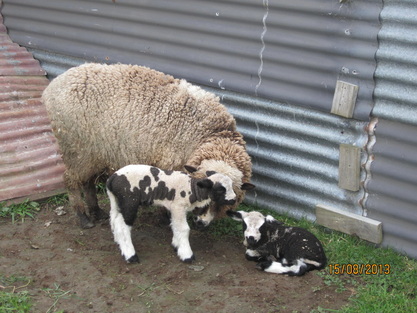 The last few weeks have been insanely busy! Added to everything else, it's lambing time, which has had it's own challenges. I've had very little time to do much in the garden. As readers will be aware, I've been trying to plant mostly according to the moon calendar. This month, the main planting dates are Aug 9-19, but a combination of weather, visitors, lambing and illness has prevented me doing any planting so far. On Saturday I had planned to plant as much as possible - but an earthquake on Friday caused a leaking drain in our wall which needed urgent attention, we woke to torrential rain, and that morning my youngest ewe gave birth to twins, but had no milk so I spent most of the day getting them feeding (she's now managing to feed the boy twin, but I'm having to bottle feed the girl). The ones pictured above are another set of twins, born on Wednesday morning. They're a boy and girl too - so cute! My last ewe gave birth this morning to a hefty male lamb - that makes 2 singles and 5 sets of twins this year. Yesterday we had visitors, and so today is planting day, no excuses! I've got 3 Chilean Guavas to plant, along with a bunch of polyanthus. I'm also going to soak some peas and plant them this afternoon, clean out my seed trays and start seeds of everything possible. It's technically still winter here, though very mild, but I have to assume we'll get more hard frosts, so will be starting seeds and keeping them covered for now (except the peas which will go right in the garden). I also have some celery seedlings I've been nursing over winter - I'm going to go ahead and put them out in the garden and see what happens. In addition, I need to dig and create a new garden bed and then transplant my raspberry canes into it, and also another one for my boysenberries. I also intend to create a bed and transplant the black current plants that have been quietly growing from cuttings I was given last year. I'm needing to add sides to my impromptu compost bin, and then dig out the main chicken run and refresh it with new sawdust. I treated those hens for worms a couple of days ago, so now is the time to do it. The loose stuff from the top will go in the compost, the old rotted sawdust/manure will go straight into the new garden beds. So, all in all a full day ahead. |
AuthorThis page is my blog formerly known as Kiwi Urban Homestead. Archives
February 2016
Categories
All
|
 RSS Feed
RSS Feed
